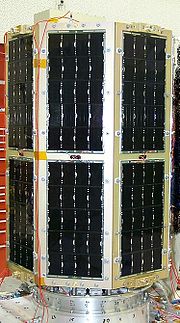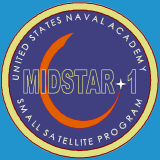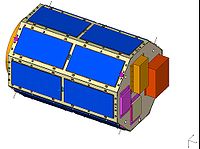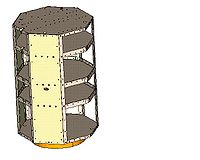
MidSTAR I (USNA)
Encyclopedia

Satellite
In the context of spaceflight, a satellite is an object which has been placed into orbit by human endeavour. Such objects are sometimes called artificial satellites to distinguish them from natural satellites such as the Moon....
produced by the United States Naval Academy
United States Naval Academy
The United States Naval Academy is a four-year coeducational federal service academy located in Annapolis, Maryland, United States...
Small Satellite Program (SSP). It was sponsored by the United States Department of Defense
United States Department of Defense
The United States Department of Defense is the U.S...
(DoD) Space Test Program
Space Test Program
The Space Test Program is the primary provider of spaceflight for the United States Department of Defense space science and technology community. STP is conducted by the Space Development and Test Wing of the United States Air Force...
(STP), and was launched on March 8, 2007 at 11:32 Eastern Standard Time
Eastern Standard Time
Eastern Standard Time may refer to:*North American Eastern Time Zone, UTC-5*Australian Eastern Standard Time, UTC+10*An album by Hip Hop group Kooley High...
, aboard an Atlas V
Atlas V
Atlas V is an active expendable launch system in the Atlas rocket family. Atlas V was formerly operated by Lockheed Martin, and is now operated by the Lockheed Martin-Boeing joint venture United Launch Alliance...
expendable launch vehicle from Cape Canaveral Air Force Station
Cape Canaveral Air Force Station
Cape Canaveral Air Force Station is an installation of the United States Air Force Space Command's 45th Space Wing, headquartered at nearby Patrick Air Force Base. Located on Cape Canaveral in the state of Florida, CCAFS is the primary launch head of America's Eastern Range with four launch pads...
. MidSTAR-1 flew along with FalconSat 3, STPSat 1, and CFESat
CFESat
CFESat, the Cibola Flight Experiment Satellite, examines radio spectra for ionospheric and lightning studies, using field-programmable gate arrays...
as secondary payloads; the primary payload was Orbital Express
Orbital Express
thumb|Orbital Express: ASTRO and NEXTSatOrbital Express was a space mission managed by the United States Defense Advanced Research Projects Agency and a team led by engineers at NASA's Marshall Space Flight Center...
.
MidSTAR-1 Mission (USNA-5)

of space experiments and instruments. The integration of the experiments with the satellite bus must be accomplished with minimal changes to the satellite bus design. MidSTAR is intended to be a relatively low-cost, quick response platform accommodating small payloads approved by the DoD Space Experiments Review Board (SERB) and awaiting launch through STP.
MidSTAR is designed for use on the EELV Secondary Payload Adapter
EELV Secondary Payload Adapter
The EELV Secondary Payload Adapter is an interstage adapter ring utilized for launching secondary payloads on US DoD space missions that utilize the Evolved Expendable Launch Vehicles Atlas V and Delta IV. This reduces launch costs for the primary mission and enables secondary and even tertiary...
(ESPA) Ring developed by Air Force Research Laboratory (AFRL) for placement on Delta IV or Atlas V
Atlas V
Atlas V is an active expendable launch system in the Atlas rocket family. Atlas V was formerly operated by Lockheed Martin, and is now operated by the Lockheed Martin-Boeing joint venture United Launch Alliance...
expendable launch vehicles. MidSTAR is a Class D spacecraft, produced at minimum cost with a correspondingly higher technical risk in production and operation. It is intentionally simple in design and rugged in construction, using commercial off-the-shelf “plug-and-play” components to the greatest extent possible. Component development and circuit-board level design are accomplished only when necessary.
MidSTAR-1 is the first implementation of the design. It was commissioned by STP to carry the Internet Communications Satellite (ICSat) Experiment for SSP and the Configurable Fault Tolerant Processor (CFTP) Experiment for Naval Postgraduate School
Naval Postgraduate School
The Naval Postgraduate School is an accredited research university operated by the United States Navy. Located in Monterey, California, it grants master's degrees, Engineer's degrees and doctoral degrees...
(NPS). In addition, MidSTAR-1 carries the Nano Chem Sensor Unit (NCSU) for the National Aeronautics and Space Administration (NASA) Ames Research Center; Eclipse, built by Eclipse Energy Systems, Inc. for NASA Goddard Space Flight Center
Goddard Space Flight Center
The Goddard Space Flight Center is a major NASA space research laboratory established on May 1, 1959 as NASA's first space flight center. GSFC employs approximately 10,000 civil servants and contractors, and is located approximately northeast of Washington, D.C. in Greenbelt, Maryland, USA. GSFC,...
(GSFC); and the Micro Dosimeter Instrument (MiDN), sponsored by the National Space Biomedical Research Institute (NSBRI) and built by the USNA Department of Aerospace Engineering. The mission is intended to last two years.
Mission Architecture
The MidSTAR-1 mission includes a single spacecraft under the command and control of a single satellite ground station (SGS) located at the United States Naval AcademyUnited States Naval Academy
The United States Naval Academy is a four-year coeducational federal service academy located in Annapolis, Maryland, United States...
, Annapolis MD. The ground station forwards downlinked data files to the Principal Investigators via the Internet. The launch segment for MidSTAR-1 utilized an Atlas V
Atlas V
Atlas V is an active expendable launch system in the Atlas rocket family. Atlas V was formerly operated by Lockheed Martin, and is now operated by the Lockheed Martin-Boeing joint venture United Launch Alliance...
launch vehicle through the Space Test Program
Space Test Program
The Space Test Program is the primary provider of spaceflight for the United States Department of Defense space science and technology community. STP is conducted by the Space Development and Test Wing of the United States Air Force...
, placing the satellite in a circular orbit
Circular orbit
A circular orbit is the orbit at a fixed distance around any point by an object rotating around a fixed axis.Below we consider a circular orbit in astrodynamics or celestial mechanics under standard assumptions...
at 496 km altitude, 46 degrees inclination.
The satellite uses an uplink at 1.767 GHz with an IF
Intermediate frequency
In communications and electronic engineering, an intermediate frequency is a frequency to which a carrier frequency is shifted as an intermediate step in transmission or reception. The intermediate frequency is created by mixing the carrier signal with a local oscillator signal in a process called...
frequency of 435 MHz, and a 2.20226 GHz Downlink. By utilizing a Gaussian
GAUSSIAN
Gaussian is a computational chemistry software program initially released in 1970 by John Pople and his research group at Carnegie-Mellon University as Gaussian 70. It has been continuously updated since then...
Mean Shift Key modulation
Modulation
In electronics and telecommunications, modulation is the process of varying one or more properties of a high-frequency periodic waveform, called the carrier signal, with a modulating signal which typically contains information to be transmitted...
, communications with the satellite are achieved at 68.4 kbit
Kilobit
The kilobit is a multiple of the unit bit for digital information or computer storage. The prefix kilo is defined in the International System of Units as a multiplier of 103 , and therefore,...
/s or higher data rate. The satellite also uses open source software based on Linux
Linux
Linux is a Unix-like computer operating system assembled under the model of free and open source software development and distribution. The defining component of any Linux system is the Linux kernel, an operating system kernel first released October 5, 1991 by Linus Torvalds...
operating system
Operating system
An operating system is a set of programs that manage computer hardware resources and provide common services for application software. The operating system is the most important type of system software in a computer system...
. MidSTAR-1 has no attitude control or determination, no active thermal control, and it's mass is 120 kg.
One hundred percent success was be the successful launch and operation of the satellite with full support for the two primary experiments for two years. Fifty percent success was the successful launch and operation of the satellite with: Full support of one primary experiment for two years; Full support of both primary experiments for one year; or, Partial support of both primary experiments for two years. Thirty-three percent success was successful launch of the satellite and full operation of the satellite bus with partial support of any combination of primary and secondary payloads for any length of time.
Mission Log
9 March 2007: MidSTAR-1 flew as part of the STP-1 mission on a United Launch Alliance Atlas V from Cape CanaveralCape Canaveral
Cape Canaveral, from the Spanish Cabo Cañaveral, is a headland in Brevard County, Florida, United States, near the center of the state's Atlantic coast. Known as Cape Kennedy from 1963 to 1973, it lies east of Merritt Island, separated from it by the Banana River.It is part of a region known as the...
Air Force Station. Liftoff occurred at 0310 UTC; spacecraft separation occurred at 0332 UTC. USNA SGS successfully acquired communications with the spacecraft during the first pass over Annapolis MD
Maryland
Maryland is a U.S. state located in the Mid Atlantic region of the United States, bordering Virginia, West Virginia, and the District of Columbia to its south and west; Pennsylvania to its north; and Delaware to its east...
at 0459 UTC. The spacecraft was operating nominally in safe mode
Safe mode (spacecraft)
Safe mode is an operating mode of a modern spacecraft during which all non-essential systems are shut down and only essential functions such as thermal management, radio reception and attitude control are active.-Triggering events:...
.
21 March 2007: CFTP turned on at 2217 UTC to add 6 W continuous to the electrical power system load and thus lessen charging stress on the batteries.
28 March 2007: MiDN turned on at approximately 2400 UTC. Spacecraft stopped responding to all ground commands subsequent to this pass.
4 April 2007: First use of "firecode reset" of spacecraft at approximately 2130 UTC. This command toggles the reset switch on the MIP-405 processor and reboots the operating system. This reset returned the CFTP and MiDN experiments to "off" and cleared all command buffers. At 2324 UTC the spacecraft responded to a "transmitter on" command. Telemetry confirmed that the reboot was successful.
5 April 2007: CFTP and MiDN turned back on.
6 April 2007: Selective download of MiDN files retrieved 71 files of 92 byte
Byte
The byte is a unit of digital information in computing and telecommunications that most commonly consists of eight bits. Historically, a byte was the number of bits used to encode a single character of text in a computer and for this reason it is the basic addressable element in many computer...
s each which were delivered to the Principal Investigator (PI). This was the first successful retrieve of science data from the spacecraft. With this milestone, MidSTAR-1 satisfied the criteria of 33% mission success.
26 May 2007: NCSU turned on at approximately 1900 Z
Z
Z is the twenty-sixth and final letter of the basic modern Latin alphabet.-Name and pronunciation:In most dialects of English, the letter's name is zed , reflecting its derivation from the Greek zeta but in American English, its name is zee , deriving from a late 17th century English dialectal...
.
29 May 2007: First data package delivered to NCSU PI. All four experiments are on and delivering data to the PIs.
18 June 2007: NASA press release announces success of NCSU.
5 September 2007: Spacecraft computer froze as a result of unknown influences, most likely radiation-induced upsets. This happened while the spacecraft was in full sun and with the power drains (30 W) on to prevent battery overcharging. Without the computer to cycle the drains off, the spacecraft remained in a continuous negative net power configuration which eventually drained the batteries. When the battery voltage dropped below 8 V, the electronic switches for the drains defaulted to off, returning the spacecraft to positive net power and allowing the batteries to recharge.
7 September 2007: Once the batteries recharged sufficiently, the computer restarted successfully. Restart occurred 48 hours after the initial event. No telemetry from the spacecraft or any experiment is available for that 48 hour period. Telemetry indicates that normal operation resumed, but all experiments were left off pending post-event analysis and the development of a plan to bring them back online.
12 September 2007: CFTP restarted.
21 September 2007: MiDN restarted.
April 2009: Contact with MidSTAR-1 lost. Spacecraft ceased transmitting and failed to respond to ground command. Anomaly attributed to failure of battery packs. MidSTAR-1 declared non-operational. MidSTAR-1 fully supported all onboard experiments for two full years, fulfilling the 100% success criteria.
Structure

Inch
An inch is the name of a unit of length in a number of different systems, including Imperial units, and United States customary units. There are 36 inches in a yard and 12 inches in a foot...
along the long axis, including separation system, and 21.2"x21.2" measured side-to-side in cross-section. The deployment mechanism is mounted on the negative x face. The positive x face is reserved for externally mounted experiments. Of the 38" along the x-axis allowed in the ESPA
Espa
Espa is a village in the municipality of Stange, Norway. It is located by the European route E6. Its population is 191.-External links:...
envelope, 2-4" are reserved for the deployment mechanism (15-in motorized lightband manufactured by Planetary Systems, Inc.), and 4-6" are reserved for external experiments. The frame length is 30". All eight sides of the spacecraft are covered with solar cells in order to maximize the power available. Eight dipole antennas are mounted on the four faces of the spacecraft which "cut the corners" of the ESPA envelope, and are therefore positioned within the ESPA envelope rather than coincident with the envelope surface. The remaining sides are mounted with remove-before-flight eyeholes for lifting and transport during ground support.

Center of gravity
In physics, a center of gravity of a material body is a point that may be used for a summary description of gravitational interactions. In a uniform gravitational field, the center of mass serves as the center of gravity...
requirements.
The load-bearing structure of the octagon consists of the top and bottom decks, connected at the eight corners by stringers. The side panels of the spacecraft are 1/8" aluminum panels mounted to the stringers with #10 bolts.
Command and Data Handling (C&DH)
The mission of the Command and Data Handling System (C&DH) is to receive and execute commands; collect, store, and transmit house-keeping data; and support the onboard payloads. The flight computer is designed to control the satellite and manage telemetry and experiment data for a minimum of two years.The C&DH system consists of a custom-modified MIP405-3X single board computer which included (i) 133 MHz PowerPC processor; (ii) 128 MB
Megabyte
The megabyte is a multiple of the unit byte for digital information storage or transmission with two different values depending on context: bytes generally for computer memory; and one million bytes generally for computer storage. The IEEE Standards Board has decided that "Mega will mean 1 000...
ECC
ECC
-Companies:* ECC , Education through Communication for the Community, a Japanese company* Electric Car Corporation plc, a British adapter and seller of electric cars* English China Clays, an English company-Education:...
; (iii) 4 RS-232 asynchronous serial ports; (iv) 1 Ethernet Port; (v) a PC/104 bus; (vi) a PC/104+ bus; and, (vi) a 202-D384-X Disc on Chip providing 384 MB of secondary storage. The computer board is supported by an ESCC-104 Synchronous Serial Card with 2 synchronous serial ports, and an EMM-8M-XT Serial Expansion Card with 8 RS-232
RS-232
In telecommunications, RS-232 is the traditional name for a series of standards for serial binary single-ended data and control signals connecting between a DTE and a DCE . It is commonly used in computer serial ports...
/422/485 asynchronous serial ports and 8 digital I/O channels. A modified I0485 data acquisition board provides 22 analog
Analog signal
An analog or analogue signal is any continuous signal for which the time varying feature of the signal is a representation of some other time varying quantity, i.e., analogous to another time varying signal. It differs from a digital signal in terms of small fluctuations in the signal which are...
telemetry
Telemetry
Telemetry is a technology that allows measurements to be made at a distance, usually via radio wave transmission and reception of the information. The word is derived from Greek roots: tele = remote, and metron = measure...
channels and 32 digital I/O channels.
The decision to use the PowerPC based MIP405 over an x86 based board was based solely on the low power consumption of the board combined with the feature set. The choice was limited to x86, PowerPC, and ARM
ARM architecture
ARM is a 32-bit reduced instruction set computer instruction set architecture developed by ARM Holdings. It was named the Advanced RISC Machine, and before that, the Acorn RISC Machine. The ARM architecture is the most widely used 32-bit ISA in numbers produced...
processor architectures because of a program decision to use the Linux operating system. The MIP405 integrates Ethernet, serial ports, and Disk-on-Chip interface on a single board while providing 128 MB of ECC memory and a powerful processor for under 2 watts. The closest x86 based system with comparable features found consumed 5 watts of power.
The M-Systems Disk-on-Chip was chosen because it was the de facto standard flash memory harddisk replacement. Flash memory was chosen over a traditional hard disk to increase reliability and reduce power. The 384 MB version was chosen to provide the storage required for the operating system and still maintain adequate margin.
The Diamond Systems Emerald-MM-8 was chosen for the asynchronous serial board based on its innate flexibility with any of the 8 ports capable of being configured as RS-232, RS-422, RS-485.
RMV's IO485 data acquisition and control board was chosen for the distributed telemetry system because of built-in support for daisy chaining and handling a large number of boards. The integrated expandability is fundamental to addressing future telemetry issues in later versions of the MidSTAR line.
The C&DH uses the Linux operating system with a 2.4 series kernel. To create an open software architecture the IP protocol stack was chosen to provide inter process, intra-satellite, and satellite-ground communications. This allowed programs created at different facilities on different hardware to be integrated with minimum difficulty.
All internal and external communications use internet protocols. TCP is used for all internal satellite communications; UDP or MDP is used on the uplink and downlink.
See also
- USNA MidSTAR ProgramUSNA MidSTAR Program-MidSTAR program mission:MidSTAR is a general-purpose satellite bus capable of supporting a variety of space missions by easily accommodating a wide range of space experiments and instruments....
- eoPortal describes MidSTAR-1

